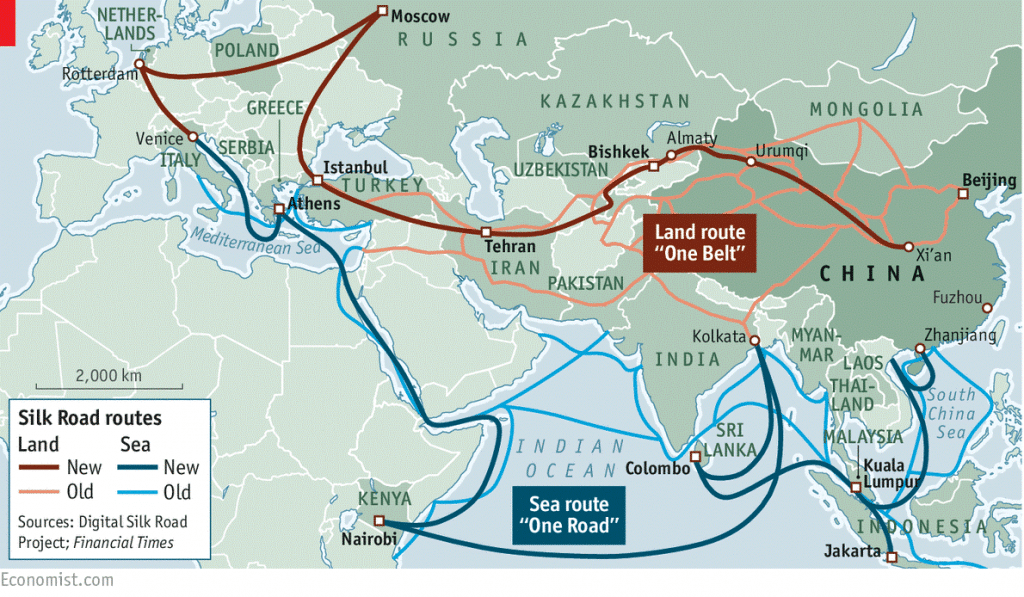By: Rafał Grabowski, Key Account Manager, ET2C Poland

In 2013, a great idea was created: connecting China to Europe by land and developing trasnsport routes that would be able to compete with sea and air routes. The Belt and Road Initiative (BRI, 一带一路in Chinese), as the project was branded, would become the largest infrastructural project in the history of the world.
The Belt and Road Initiative, also sometimes called ”new Silk Road”, represents a envisioned network of transport corridors that would link China with Europe. This means construction or upgrading of railway trade connections, especially between Europe and Asia, including high speed railways, roads, ports and airports, as well as the creation of the transmission infrastructure (oil pipelines, gas pipelines) and telecommunications. Currently, only 3.5% of Chinese exports goes to the European Union by road. Its main advantage is the cost substantially lower than air transport and significantly shorter time than its maritime alternative. To support the project, Chinese authorities have created New Silk Road Fund with an initial capital of USD 40 billion and is being realized on the basis of cooperation with partners from Europe and Asia.

Due to its size and location, Poland is seen by China as the most important country in central Europe. This is why a proposal to position Poland as a logistic center of Europe and fully utilize the BRI benefits was created in the IMF-supported project Poland 3.0, which is envisioned an infrastructural project which should help accelerate development of transportation routes and relevant infrastructure in central Europe. It is also the largest cross-border infrastructure project in Europe, implemented through clusters and to the combination of Polish rivers, motorways and railways in one plane of multimodal transport, the construction of a Transnational logistics center in Gorzyczkach, and the BRI with the planned, multimodal logistics center.

16+1 Initiative
Poland is not the only regional country included in the project. Fifteen more countries, under the the 16+1 Initiative by China, are planning at intensifying and expanding cooperation with the Asian giant in the fields of investments, transport, finance, science, education, and culture. This includes 11 EU member states and 5 EU candidates.

- Albania
- Bosnia and Herzegovina
- Bulgaria
- Croatia
- Czech Republic
- Estonia
- Hungary
- Latvia
- Lithuania
- FYR Macedonia
- Montenegro
- Poland
- Romania
- Serbia
- Slovakia
- Slovenia
In the framework of the initiative, China has defined three potential priority areas for economic cooperation: infrastructure, high technologies, and green technologies.
The first 16+1 Summit was held in Warsaw, Poland, in 2012. At the event, the Prime Minister of China announced a comprehensive initiative on cooperation with 16 Central and Eastern European countries, entitled China’s Twelve Measures for Promoting Friendly Cooperation with Central and Eastern European Countries, which is the framework document for the 16+1 format. This was followed by summits in Bucharest, Romania (2013), Belgrade, Serbia (2014), Suzhou, China (2015) and Riga, Latvia (2016).
The BRI and Western Businesses
The Belt & Road Initiative contains two key parts: a land-based “belt” from China to Europe, evoking old Silk Road trade paths and a “road” referring to ancient maritime routes. The initiative should span over 65 countries and the WPC experts estimate the infrastructural investment needs in the region to be valued at over USD 900 billion in the next 10 years. Western multinationals, spotting a bonanza, are selling billions of dollars of equipment, technology and services to Chinese firms building along it.
For example, the US-based General Electric (GE) made sales of USD 2.3 billion in equipment orders from the BRI projects in 2016, almost three times more than the previous year. John Rice, the firm’s vice-chair, expects the firm to enjoy double-digit growth in revenues along the BRI in coming years. Other firms, such as Caterpillar, Honeywell, and ABB, global engineering giants, DHL, a logistics company, Linde and BASF, two industrial gas and chemicals manufacturers, and Maersk Group, a shipping firm, rattle off lists of BRI projects. Deutsche Bank has structured eight trade deals around it and has an agreement with the China Development Bank, one of China’s policy lenders, to fund several BRI schemes.
The important opportunities are not missed by any key players. Jean-Pascal Tricoire, the Hong Kong-based chief executive of Schneider Electric, a French energy-services firm, says that for his company Belt & Road Initiative is one of the most important plans of this century so far. Honeywell has recently formed a team called “East to Rest” that manages sales and marketing to mainland firms that are expanding abroad. As a goateed singer in Xinhua’s music video promises Chinese viewers, “when Belt and Road reaches Europe, Europe’s red wine is delivered to the doorstep half a month earlier”. For years to come, Belt & Road Initiative looks likely to be the toast of Western boardrooms, too.
